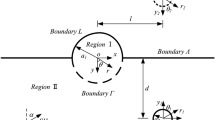Abstract
Diffraction of a two-dimensional (2D) semi-circular cavity in a half-space under incident SH-waves is studied using the classic wave function expansion method with a new de-coupling technique. This so-called “improved cosine halfrange expansion” algorithm exhibits an excellent performance in reducing displacement residual errors at two rim points of concern. The governing equations are developed in a manner that minimizes the residues of the boundary conditions. Detailed derivation and analysis procedures as well as truncation of infinite linear governing equations are presented. The semi-circular cavity model presented in this paper, due to its simple profile, is expected to be used in seismic wave propagation studies as a benchmark for examining the accuracies of various analytical or numerical methods for mixed-boundary wave propagation problems.
Similar content being viewed by others
References
Abramowitz M and Stegun IA (1972), Handbook of Mathematical Functions, with Formulas, Graphs, and Mathematical Tables, New York: Dover Publications, Inc.
Achenbach JD (1970), “Shear Waves in an Elastic Wedge,” International Journal of Solids and Structures, 6(4): 379–388.
Hinders MK and Yaghjian AD (1991), “Dual-series Solution to Scattering from a Semicircular Channel in a Ground Plane,” IEEE Microwave and Guided Wave Letters, 1(9): 239–242.
Lee VW (1977), “On Deformations Near Circular Underground Cavity Subjected to Incident Plane SH-Waves,” Proceedings of the Application of Computer Methods in Engineering Conference, Los Angeles, CA, pp. 951–962.
Lee VW and Cao H (1989), “Diffraction of SV Waves by Circular Cylindrical Canyons of Various Depths,” Journal of Engineering Mechanics, ASCE, 115(9): 2035–2056.
Lee VW, Luo H and Liang J (2004), “Diffraction of Anti-plane SH Waves by a Semi-circular Cylindrical Hill with an Inside Concentric Semi-circular Tunnel,” Earthquake Engineering and Engineering Vibration, 3(2): 249–262.
Lee VW, Luo H and Liang J (2006), “Anti-plane (SH) Waves Diffraction by a Semi-circular Cylindrical Hill Revisited: An Improved Accurate Wave Series Analytic Solution,” Journal of Engineering Mechanics, ASCE, 132(10): 1106–1114.
Lee VW and Manoogian ME (1995), “Surface Motion above an Arbitrary Shape Underground Cavity for Incident SH Waves,” Journal of European Earthquake Engineering, 7(1): 3–11.
Lee VW and Sherif RI (1996), “Diffraction around Circular Canyon in Elastic Wedge Space by Plane SH Waves,” Journal of Engineering Mechanics, ASCE, 122(6): 539–544.
Lee VW and Trifuanc MD (1979), “Response of Tunnels to Incident SH-Waves,” Journal of the Engineering Mechanics Division, ASCE, 105(4): 643–659.
Liang J, Luo H and Lee VW (2010), “Diffraction of Plane SH Waves by a Semi-circular Cavity in Halfspace.” Earthquake Science,23(1): 5–12.
Luo H (2008), “Diffraction of SH-waves by Surface or Sub-surface Topographies with Application to Soilstructure Interaction on Shallow Foundations,” PhD Dissertation, University of Southern California, Los Angeles, California.
MacDonald HM (1902), Electric Waves. London, England: Cambridge University Press.
Pao YH and Mow CC (1973), Diffraction of Elastic Waves and Dynamics Stress Concentrations. New York: Crane, Russak & Company Inc.
Park TJ, Eom HJ, Boerner WM and Yamaguchi Y (1992), “TM Scattering from a Dielectric-loaded Semi-circular Trough in a Conducting Plane,” IEICE Transaction of Communication, E75-B(2): 87–91.
Sanchez-Sesma FJ (1985), “Diffraction of Elastic SHwaves in Wedges,” Bulletin of the Seismological Society of America, 75(5): 1435–1446.
Yuan X and Liao ZP (1996), “Surface Motion of a Cylindrical Hill of Circular-arc Cross-section for Incident Plane SH Waves,” Soil Dynamics and Earthquake Engineering, 15(3): 189–199.
Yuan X and Men FL (1992), “Scattering of Plane SH Waves by a Semi-cylindrical Hill,” Earthquake Engineering and Structural Dynamics, 21(12): 1091–1098.
Author information
Authors and Affiliations
Corresponding author
Rights and permissions
About this article
Cite this article
Luo, H., Lee, V.W. & Liang, J. Anti-plane (SH) waves diffraction by an underground semi-circular cavity: analytical solution. Earthq. Eng. Eng. Vib. 9, 385–396 (2010). https://doi.org/10.1007/s11803-010-0023-3
Received:
Accepted:
Published:
Issue Date:
DOI: https://doi.org/10.1007/s11803-010-0023-3




